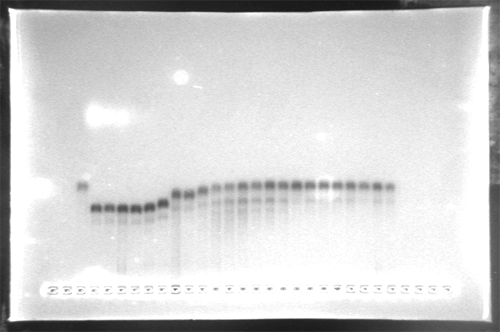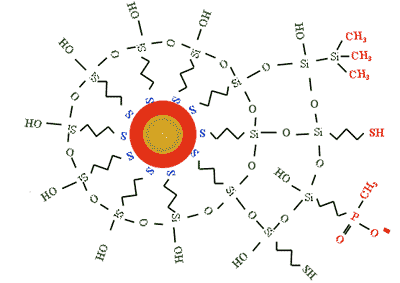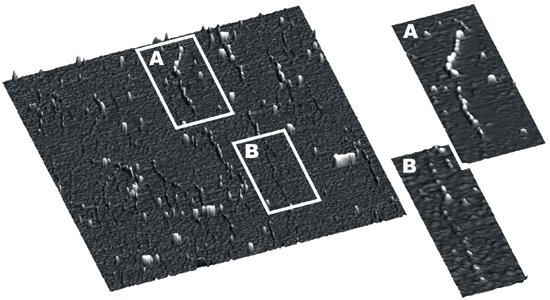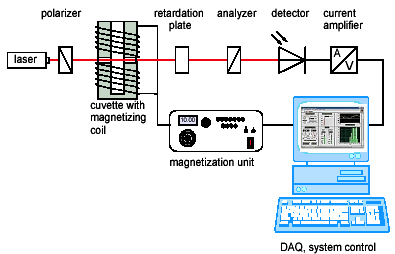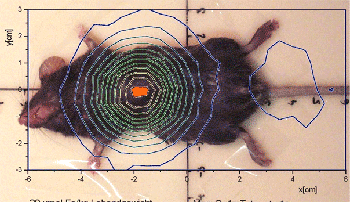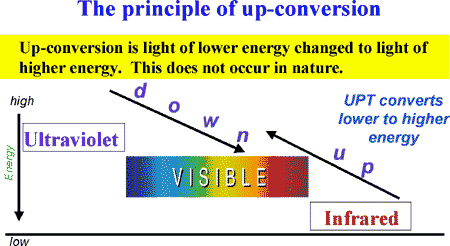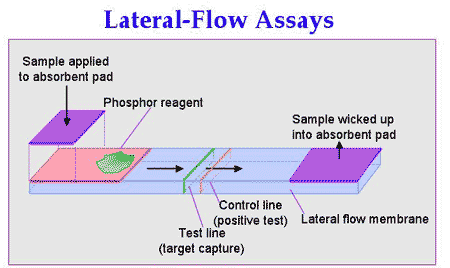Oligonucleotide Conjugated Gold Particles for Genomic Analysis Y. Paul Bao, Sudhakar S. Marla, James J. Storhoff, Tai-Fen Wei, Susan Hagenow, Hitesh Mehta, Adam Lucas, Viswanadham Garimella, William Cork and Uwe Müller Nanosphere, Inc., Northbrook, IL 60062, USA Fluorescent labels, either incorporated directly into the target sequence or attached indirectly, represent the basis for the currently preferred labeling scheme in biomolecule detection and array applications, but an increasing emphasis on higher sensitivity has led to the development of dendrimers, quantum dots, up-converting phosphors and nanoparticles.Silver amplified 13 nm gold-nanoparticle probes have been shown to allow high sensitivity detection since they can be detected by light scatter at a density as low as ~0.0025 probes/um2, using Nanosphere's extremely low-cost evanescence-based image analysis system. This is on the order of 1000-fold more sensitive than laser scanning-based fluorescence detection on a particle to molecule basis. We have developed a highly effective method for functionalizing nanoparticles with modified oligonucleotides. The oligo-coated nanoparticles result in probes of high chemical and thermal stability, low non-specific binding, and sharp melting transitions. These probes can hybridize to nucleic acid targets under conditions of significantly elevated stringency and achieve high specificity. We have applied this remarkably specific and sensitive nanoparticle-based analysis system to the development of microarray based research as well as diagnostic assay systems. Preliminary data suggest attomolar sensitivity when testing for infectious agents and genetic predispositions in model systems with single-nucleotide discrimination. In fact, our probes show sufficient discrimination power to differentiate between unique single nucleotide polymorphisms in the presence of total human DNA. Furthermore, we have successfully developed a universal nanoparticle probe system that allows label-free mRNA detection in expression arrays and have observed more than 40-fold increased sensitivity. Fluorescent and magnetic nanoparticles for molecular diagnostics of nucleic acids on a single molecule level Frank F. Bier, Ralph Hölzel, Nenad Gajovic-Eichelmann, Alexander Christmann Fraunhofer Institute for Biomedical Engineering, Dept. Molecular Bioanalytics, Bergholz-Rehbrücke, Germany Analytic and clinical diagnostic on a single molecule level is of great interest in all that cases where only few or even single cells are to be investigated. Especially on the genomic level e.g. for the analysis of transcriptomes single events are ruling the behaviour of the cell as a whole and might be crucial for the formation of cancer. Nanoparticles are an alternative method to enhance signals linked to single molecular binding events. In our studies we use stretched long DNA strands of several Ám length (< 7000 bp). As has been reported previously long doublestranded DNA may be stretched by virtue of alternating electric fields. Recently we found that also single stranded DNA may be stretched in the same way. Defined sites on stretched DNA can easily be addressed by an oligonucleotide that is complementary to this site. To visualise such single oligonucleotides fluorescent particles enhance the signal compared to fluorochrome label by several orders of magnitude. An alternate label are magnetic particles of 50 nm diameter. This type of particles are well distinguishable by Magnetic Force Microscopy (MFM) with an extremely high signal to noise ratio. Moreover, such labels are also used as construction tools to direct the captured end of a long DNA fragment to a defined position. Inorganic Nanoparticles in Medical Diagnostics K. Bohmann*, W. Hoheisel*, S. Haubold#, C. Meyer#, M. Haase+, *Bayer AG, D-51368 Leverkusen, Germany; #Nanosolutions GmbH, D-22525 Hamburg, Germany; +Phys.-Chem. Institut, Univ. Hamburg, D-20146 Hamburg, Germany Advances in producing and handling nanoscaled materials lead to increasing commercial interests in the use of these materials. One of the first sophisticated nano-products could be introduced in medical diagnostics for labeling biomolecules. Immunoassays, biosensors or PCR processes often rely on fluorescent labels to quantify analytes like antibodies or DNA-strands. Organic molecular dyes still dominate this field even though they show some crucial drawbacks like fading or limited capabilities to detect several analytes in parallel (multiplexing). Due to the need for alternative approaches a number of new technologies is being developed employing gold colloids or quantum dots. The use of nano-sized, phosphorescent particles is a less known approach for fluorescent biolabels even though they show decisive advantages. Nanophosphors are environmentally acceptable nanocrystals like LaPO4, Y2O3 or sulfates being doped with Rare Earth ions. Upon UV-excitation they fluoresce with a characteristic, narrow banded wavelength pattern which is independent of the particle size. This again strongly facilitates large scale production. Furthermore, long living excited states with half-lifes in the millisecond range allow time resolved measurements with increased sensitivity due to background free detection. It could be demonstrated that nanophosphors can be quenched via fluorescence resonance energy transfer (FRET) to attached dyes. Exemplified by oligonucleotides coupled to LaPO4:Ce,Tb we could demonstrate the feasibility of homogeneous assays which renders nanophosphors superior over other particle based systems. For any new biolabel system this is an important condition for a broad use outside market niches. Optical detection of individual nanoparticle labels after metal enhancement Andrea Csáki,*, Pia Kaplanek, Wolfgang Fritzsche Biotechnical Microsystems Department, Institute for Physical High Technology, Jena, Germany The detection of DNA using nanoparticle label is an interesting alternative to the standard fluorescence technique. It requires simpler detection equipment, resulting in higher stability and lower costs. Beside easier detection, metal enhancement results in a higher sensitivity of detection. The signal-response curve for labeled DNA before and after silver enhancement was studied, applying both AFM and optical (reflection/absorption) measurements. So the dynamic range and the sensitivity were determined for nanoparticle labeling with and without metal enhancement. The ultimate limit of detection, the identification of individual labels, is demonstrated for the optical readout of metal-enhanced gold nanoparticle. Therefore, chosen nanoparticles were visualized before and after enhancement, so that the individual optical signals could be clearly related to either single or multiple nanoparticles. Gold nanoparticle labels in electrochemical ligand-binding assays:application to the detection of viral DNA hybridization Murielle Dequaire, Céline Grossiord, Laurent Authier, Benoít Limoges, Pierre Brossier Laboratoire de Microbiologie Médicale et Moléculaire, Facultés de Médecine et de Pharmacie, 7 Boulevard Jeanne d'Arc, 21000 Dijon, France Gold nanoparticles labels have gained considerable interests in the development of ligand-binding assays (immunoassays, hybridization tests) because many analytical methods are suitable for their quantitative detection, e.g., colorimetric absorption spectrophotometry, microgravimetry, scanning force microscopy, surface plasmon resonance... Recently, we have developed a novel electrochemical amplification strategy for the sensitive detection of colloidal gold nanoparticles by determining the amount of AuIII ions released in solution from each nanoparticle after oxidative treatment in an acidic solution [1]. For this purpose, we have employed the highly sensitive anodic stripping voltammetry (ASV) at a disposable carbon-based screen-printed electrode. An increase of sensitivity was obtained at a screen-printed microband electrode (AuIII detection limit of 5 x 10-9 M) which allows for the enhancement of AuIII ions mass transfert and thus for simplified measurements in small volumes of quiescent solution [2]. The analytical performance of this gold nanoparticle-based electrochemical HCMV-DNA hybridization assay will be discussed and compared with previously reported HCMV DNA hybridization tests involving an enzyme label [3]. 1. Dequaire M, Degrand C, Limoges B. Anal Chem 2000; 72, 5521-8. Substrate modification for gold nanoparticle labeling Grit Festag, Andrea Steinbrück, Andreas Wolff, Andrea Csáki, Robert Mölller, Wolfgang Fritzsche Biotechnical Microsystems Department, Institute for Physical High Technology, Jena, Germany, Immobilized DNA can be detected by complementary, nanoparticle-labeled DNA. For parallel readout, optical and electrical detection methods have been introduced. Silver enhancement of gold nanoparticles allows the optical readout by standard flatbed scanners. However, substrate modification, enabling DNA binding, could lead to inhomogeneous surfaces and unspecific bindings of the gold particles. Contact angle measurements as well as fluorescence, AFM and a flatbed scanner were used to analyze the multiple step process, including substrate surface modification, immobilization of the capture DNA, specific binding of the gold-labeled DNA probe, and their enhancement by silver deposition. Labeling Biomolecules with Nano Metal Particles James F. Hainfeld Nanoprobes, Inc., 95 Horseblock Rd., Yaphank, New York, USA 11980; & Brookhaven National Laboratory, Bldg. 463, Upton, New York, USA 11973 The early history of labeling biomolecules with metal clusters will be presented, as well as recent developments. Labeling of various proteins, peptides, nucleic acids, lipids, and other molecules using small, well-defined gold compounds is possible with specific coupling chemistry. The types of metal clusters can be varied, and include gold, platinum, silver, iridium, tungsten, and other metals that form nanoparticles. Another related technology is autometallography, where the initial metal nanoparticle serves as a nucleation center for additional metal deposition, typically of silver, but may also include gold, copper, and other metals. This grows the small particles into more detectable sizes, thus increasing sensitivity. Gold labeled proteins may also be combined with fluorophores to produce dual probes useful for correlative light and electron microscopy. There are many uses of these technologies, such as immunohistochemistry, in situ hybridization (even detection of single gene copies), nanomaterials, nanoelectronics, disease detection, bioterrorism detection, cell and molecular studies, gene transfection, gene and enzyme control, and in vivo applications, just to name a few. DNA Nanowires: 1.4 nm Nanogold clusters (bright spots) bound to double stranded bacteriophage T7 DNA (rope-like strands). Dark field, unstained STEM image on a thin carbon substrate. Full width 128 nm. Magnetic nanoparticles for the treatment of tumours by magnetic heating Ingrid Hilger Institute for Diagnostic and Interventional Radiology, University Hospital Jena, Germany The therapeutic strategy for the treatment of tumours is being changing in the last time. Particularly for breast cancers, an increasing incidence of small tumours with good prognosis is being detected due to the improvements of diagnostic methods. Radical mastectomy (the total excision of the breast) is being applied only in cases with multicentricity, multifocality, tumour spreading over several quadrants or extensive infiltration. In contrast to that, breast conserving therapies are gaining an increased significance. Newer investigations are dealing with further steps towards the minimal-invasive elimination of tumours. Conjugation of Au-nanoparticles with DNA Almudena Muñoz Javier, Teresa Pellegrino, Stefan Kudera, Wolfgang J. Parak Center of Nanoscience, Ludwig-Maximilians-Universität München, Amalienstraže 54, Germany For optical investigations of the quenching of fluorophores on gold surfaces it is important to control the distance between the fluorophore and the gold. For this purpose we use DNA of different length as spacer between fluorophore and gold. To do so we incubate gold nanoparticles with DNA which is functionalized at one side with the fluorophore and at the other side with a thiol-group that can bind to gold. To control the conformation of the DNA we make a series of different DNA to gold ratios and run them on an agarose gel. This is an example of this gel: Enzymatic manipulation of DNA/Gold Nanostructures Antonios G. Kanaras*#, Zhenxin Wang*, Andrew D. Bates#, Richard Cosstick* and Mathias Brust* Centre for Nanoscale Science: * Department of Chemistry, The University of Liverpool, Liverpool L69 7ZD, UK.# School of Biological Sciences, The University of Liverpool, L69 7ZB, UK DNA manipulation enzymes (restriction endonucleases, ligases) have been employed to control the assembly of gold/DNA hybrid nanostructures. Using these well-established bio-molecular tools it is now possible to carry out multi-step syntheses of nanostructures following concepts, which are very similar to those known from preparative chemistry. The elemental building blocks of these structures are gold nanoparticles, which carry a number of double stranded DNA molecules in their ligand shell. The base sequences of these molecules determine whether they can be converted into reactive sites by cleavage with specific restriction enzymes. The ends of such cleaved strands are phosphate activated and can participate in a further enzyme dependent reaction, which links them covalently to other reactive sites present in the system. This second step is catalysed by a DNA ligase. It is shown that nanostructures can be assembled in multi-step syntheses by successively addressing different DNA molecules with different restriction enzymes. Reactive sites are only created when the recognition sequence required by the particular enzyme employed is present. All other DNA molecules not containing this recognition site will remain un-reactive and can be activated in further steps by enzymes that recognise different sites. This concept represents a nano-scale analogue of the use of protecting groups in preparative chemistry. It is further demonstrated that existing gold/DNA nanostructures can be dissociated by cleavage at predetermined sites using restriction enzymes. The principles of enzyme controlled nanostructure manipulation have been established using freely aggregating systems of gold particles and DNA in solution. The same reactions can also be carried out on surface immobilised structures, i.e. covalently attached particles can be enzymatically cleaved from a surface, or particles in solution can be ligated to reactive DNA double strands bound to a surface. This can be monitored by AFM. It is believed that the introduction of these powerful tools will bring nanostructure self-assembly a bit closer to rational chemical synthesis and thus will enable the step-by-step preparation of a number of unique, new nanostructures. Antonios G. Kanaras, Zhenxin Wang, Andrew D. Bates, Richard Cosstick, and Mathias Brust, Angewante Chemie Int. Ed., 42 (2), 191-194, 2003Towards multi-step nanostructure synthesis: programmed enzymatic self-assembly of DNA/gold systems Biomolecule-nanoparticle conjugates for bioanalysis: Nanospheres and barcoded nanowires Christine D. Keating Department of Chemistry, Pennsylvania State University Metal nanoparticles can be used as amplification or identification tags for biomolecular recognition events. In both cases, the attachment chemistry and surface coverage of biomolecules on the particle surface is critically important for retention of bioactivity. We have attached DNA and proteins to metal nanoparticles ranging from 12-nm diameter colloidal Au spheres to 6 micron long, 320 nm wide striped metal nanowires. Au nanosphere:biomolecule conjugates are useful as amplification tags, to increase sensitivity in a variety of assay formats. Metal nanowires can be encoded with submicrometer stripes by sequential electrochemical deposition within the pores of alumina membranes. The metal striping pattern, or 'barcode', is identified via the differential reflectivity of adjacent stripes using conventional light microscopy. Reflectivity-based readout of particle patterns does not interfere with the use of fluorescence for detection of analytes bound to particles by affinity capture. Spectroscopical measurements with quantum dots Stefan Kudera*, Tim Liedl*, Wolfgang J. Parak*, Tobias Schrader#, Markus Braun# *Lehrstuhl für Angewandte Physik, #Lehrstuhl für BioMolekulare Optik; Ludwig-Maximilians-Universität München, In collaboration with a spectroscopy group we attempt to gain knowledge on both the processes that occur when a quantum dot is excited and on the chemical surrounding of the crystal. The samples are investigated with different spectroscopic techniques: Standard cw-UV-Vis absorption, standard cw fluorescence spectroscopy, short time spectroscopy in the IR-range and in the visible spectrum, and continuous IR absorption spectroscopy. By means of short time absorption (both IR and visible) spectroscopy one can observe the decay channels of the excited nanocrystals. This could present a possibility to gain knowledge on the effects that lead to the bleaching of the crystals and on the interactions of the crystals with the surrounding. Ideally one would expect an exponential decay of the excitation which is the situation of an ideal two state system. Any difference from this decay mechanism has its origin in nonradiative processes. IR absorption spectroscopy (continuous wave) is well suited for the examination of the quantum dots' surface. After the synthesis of the particles, their surface is covered with molecules of the solvent in which they were grown, which makes the particles hydrophobic. Therefore, for making the particles water-soluble, one has to exchange the hydrophobic surfactant molecules by water-soluble molecules. With IR-spectroscopy we want to determine the number of surfactant molecules per nanocrystal and thus the efficiency of the exchange. This technique could help to improve the capping of the nanocrystals. Silanisation of CdSe/ZnS Nanocrystals Tim Liedl, Stefan Kudera, Wolfgang J. Parak Lehrstuhl für Angewandte Physik, Ludwig-Maximilians-Universität München, Amalienstraße 54, Germany We intend to use semiconductor-nanocrystals in biological applications. For example biomolecules can be labelled with these crystals and then tracked on their pathway through cells. Semiconductor-nanocrystals promise to improve this tracking compared to standard organic fluorophores as they do not bleach as fast as organic fluorescent dyes. The CdSe/ZnS nanocrystals synthesized in our group are not water-soluble. For the envisaged biological applications it is necessary to transfer them into water. We here present our method to perform this task. There are techniques to synthesize semiconductor-nanocrystals directly in water. But the so prepared quantum dots do not show sufficiently good stability in both their lifetime and their fluorescence for many biological applications. The main advantage of the synthesis employed in our group is that it is performed at high temperature and therefore guarantees very good lattices as defects in the lattices are healed. The idea of the silanisation is to make the particles hydrophilic by growing a silica shell around them. The process of growing the silica-shell can be broken up into three steps. 
2. Authier L, Grossiord C, Brossier P, Limoges B. Anal Chem 2001; 73, 4450-6.
3. Azek F, Grossiord C, Joannes M, Limoges B, Brossier P. Anal Biochem 2000; 284, 107-13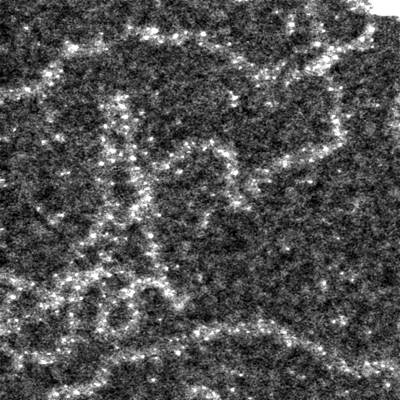
Considering this aspects, the accumulation of a magnetic material (iron oxides, e.g. magnetite) in the tumour region and the exposure of the whole breast to an alternating magnetic field was proposed. By this procedure, the magnetic material absorbs energy from the magnetic field and converts it into heat which is used to eliminate the tumour.
The elaboration of the proposed therapy conduced in a close co-operation with the Institute of Physical High Technology (Jena, Germany) method will be presented. We describe the heating potential of magnetic materials, the particle interaction with cells, the choice of magnetic field parameters taking into account the effect of unfavourable eddy current heating. We further report the functional dependencies for the expected temperature increase at the tumour site, the critical heat dose for a destruction of tumour cells, in vivo- and in vitro experimental data and numerical estimations for the feasibility of the generation of localised heat spots. The expected wash out of magnetic material from the tumour region is discussed on the base of our experimental findings.